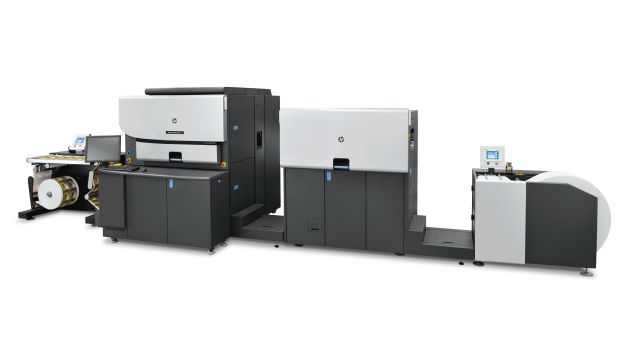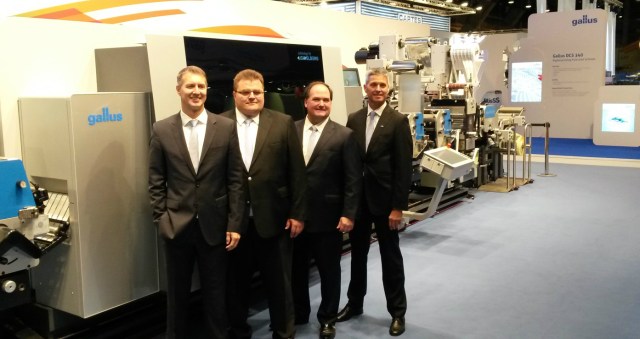
Two of the most innovative new print solutions launched at Ipex are from Australian developers Impression Technology and Rapid Machinery, with both generating serious interest on their stands. Impression Technology has launched Compress, its range of UV printers for printing promotional products, which it says offer a throughput of unprecedented levels, and an ability to print on items up to 30cm deep.

Impression Technology Development Manager John Cloake with the new high volume promotion products printer
Steve Richardson, managing director of Impression Technology says, “There is a great demand for a printer that can produce print on promotional products – pens, golf balls, boxes – with a quality and throughput that has not as yet been available. We have listened to the market, and come up with the Compress UV-600S and the Compress IUV-600 LNE.” Available as from now the Compress systems use dual water cooled UV LED lamps, which enable the high throughput. The UV-600S is has an A2 bed size, and the 300mm depth. Priced is $28,500. The IUV-600 LNE is a high volume version, it uses a cassette system to auto feed the printer, with each cassette capable of handling up to 50 trays, and the printer capable of having six cassettes. Richardson says, “This means it can handle up to 15,000 products in one go, it is set and forget.” The LNE comes in at $90,000. Impression Technology has also launched a digital label printer, the LP4, which runs at nine metres a minute on a 210mm wide web, and uses a dry toner technology.
Rapid Machinery is in the vanguard of digital printing, with its self developed Memjet powered X1, X2 and XL220 printers. Its European dealer’s stand was more than busy throughout the show. Director Ray Burton says, “Label printers are buying the Rapid systems because they offer top quality digital printing at a sensible price.” The flexibility of the systems was also cited by Burton as a reason for their success, the X2 for instance can add a range of additional functions such as foiling into its mix. At the other end of the digital scale Fujifilm was using its Jet Press 540W digital web press to produce 5,000 copies of the Ipex Daily, the 16pp show magazine.

Daily delivery: The Fujifilm Jet Press 540W printed 5,000 copies of the Ipex Daily every day at the show
Producing the Ipex daily was part of Fujifilm’s plan to show the Jet Press in action as part of a daily printing business. Each day’s 7.5 hour shift at the Fujifilm print shop produced more than 10,000 products with an average pagination of 68 pages, showing the equivalent of over 150 make readies. Fujifilm claims that compared to a conventional B2 production environment, this sees a saving of in excess of £3,500 in start-up costs. Each shift will also see Fujifilm produce over 60 types of labels on four different media on the Graphium digital label press. That equates to in excess of 500,000 labels each day, finished in-line with die cutting, slitting and rewinding. Apart from the Komori press in the eco zone the only offset presses at the show were from Chinese manufacturer Hans Gronhi, which had a B2 and B3 press running. The presses have had an upgrade, with a de-ioniser in the feeder, an updated powder spray and an upgraded chiller recirculation unit. As the only presses at the event Gronhi enjoyed more than its fair share of crowds. Gronhi which bought Japanese manufacturer Shinohara out of bankruptcy last year has just announced plans to build a new manufacturing facility in Japan where it will assemble Shinoharas for the western markets. Its presses sell on price, they come at a considerable discount to the established brands.
At a time when all the other German and Japanese press manufacturers are having to ‘rightsize’ as the euphemism goes the Chinese are expanding outwards. Aussie printers have already bought Hans Gronhi, so it will be interesting to see if they can gain much of a presence here. Komori is the sponsor of the Ipex Eco Zone, the litho press manufacturer will get to demonstrate its technology in the form of a five-colour 40″ press with coater and dryer, featuring its ozone-free, low-cost H-UV curing system. Komori was hosting half a dozen presentations a day focusing on reducing greenhouse gas emissions. The H-UV presses are low energy instant drying. Six of the last eight Komori presses sold into Australia are H-UV, reflecting a global trend that is seeing Komori H-UV presses become the dominant version of the range.
Comment below to have your say on this story.
If you have a news story or tip-off, get in touch at editorial@sprinter.com.au.
Sign up to the Sprinter newsletter




